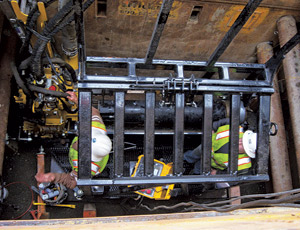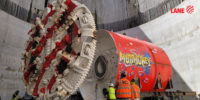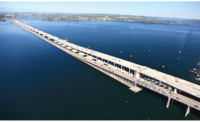The Portland, Ore., Bureau of Environmental Services and Salem, Ore.-based contractor Emery & Sons Construction Inc. on a recent project needed precision to bore a new sewer line beneath two trolley tracks near an existing steam vent in downtown Portland. They turned to an up-and-coming technology: laser-guided boring.

Using a Pella, Iowa-based Vermeer AXIS tool, the laser system provides near-exact placement of a bored tunnel and then pulls the pipe back through when complete—“a marvelous machine,” says Bill Theiss, PBES’s project manager.
The system allowed crews to run 245 ft of new sewer pipe in a high-traffic area within one week, says Dale Bettencourt, Emery & Sons project manager.
As part of a larger $2.2-million capital improvement project to update an aging sewer infrastructure, working in tight spots and digging underneath existing tracks and utilities proved daunting. “I’m just astounded by how close they can hit where they aim that thing,” Theiss says. “This is the second time we tried it, and we are starting to get a little more confident,” he adds.
The technology designed by Australian inventor Stuart Harrison, who partnered with Vermeer, works like a directional drill machine, but the ground doesn’t need to be pressurized while it bores. Emery & Sons crews dug two 8-ft by 12-ft launch and receiving pits—small sizes for this type of work—and lined up the laser with Harrison’s help.
“If you aim [the laser] in the right direction, it will go in the right direction,” Theiss says. While the machine is designed to range up to 350 ft, Emery & Sons needed it for just 245 ft of 14-in.-dia piping, a smaller size than traditional micro tunneling allows. Once the tunnel was bored, the system pulled flexible high-density polyethylene pipe back through the aperture. The crews avoided the standard procedure: jamming pipe into an existing hole.
The new tunnel, running parallel to an old clay sewer pipe, runs from 10 to 13 ft underground and within 10 ft of a steam tunnel containing 50,000 volts as well as the trolley tracks and existing storm lines. Thus, precision was key. The soft soil allowed the pipe to run straight through and fall within 0.2 inches of the final target, Bettencourt says.
As Portland continues to undergo massive sewer upgrades of its aging concrete and clay pipes, Theiss says this technology will come into play more. “There are a lot of cases where it could and probably will be used,” Theiss says. “We do have another project … that we hope … to use it on.”




Post a comment to this article
Report Abusive Comment